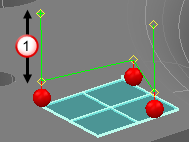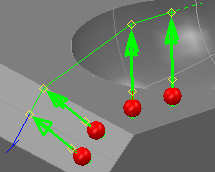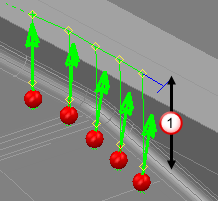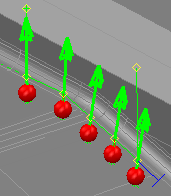The following  UserDefined probing methods are available:
UserDefined probing methods are available:
Optimal — PowerInspect creates safe moves for both the first and last probed positions in the probe path. Each safe move is created by taking the position of the feature (or of the first or last point in the surface inspection group) and moving along the feature's orientation (or along the vector of the first or last point in the surface inspection group) by the distance of the safe height  specified in the Inspect dialog.
specified in the Inspect dialog.
In between the first and last probed positions, the probe moves by the Retract distance after each position, for example:

When the Auto-Orientation button is available and not selected  , PowerInspect orientates the probe along the Z axis of the machine.
, PowerInspect orientates the probe along the Z axis of the machine.
When the Auto-Orientation button is selected  , PowerInspect orientates the probe (using the probe head) according to the surface normal of the first contact point in the probe path.
, PowerInspect orientates the probe (using the probe head) according to the surface normal of the first contact point in the probe path.
SurfaceNormal — This method is the same as Optimal, except that PowerInspect creates safe moves for all positions in the probe path, using the surface normal at each contact point. This method applies only to surface inspection groups.

SafePlane — This method moves the probe to the safe plane between each probed position.
For surface inspection groups, the plane is positioned at the safe height  above the highest point in the group, for example:
above the highest point in the group, for example:

To change the settings, click the Parameters  button in the Inspect dialog. Disabling the PointSafe parameter removes the return to safe plane moves. For example:
button in the Inspect dialog. Disabling the PointSafe parameter removes the return to safe plane moves. For example:

When the Auto-Orientation button is deselected  , PowerInspect orientates the probe along the Z axis of the machine.
, PowerInspect orientates the probe along the Z axis of the machine.
When the Auto-Orientation button is selected  , PowerInspect orientates the probe (using the probe head) according to the surface normal of the first contact point in the probe path.
, PowerInspect orientates the probe (using the probe head) according to the surface normal of the first contact point in the probe path.
TeachAndLearn — This method provides compatibility with previous versions of PowerInspect, preserving the original TeachAndLearn probe path. It uses only the probe's Approach and Retract distances, and is applicable only to files that contain probe paths created using the TeachAndLearn functions.
ZAxisSafe — This method generates a probe path that retracts the Retract distance along the surface normal, and then retracts the Safe height distance in the machine's Z axis. Use it when you want to probe a feature on an inclined or vertical plane and an obstruction prevents the probe from retracting along the surface normal.
StylusVectorSafe — This method generates a probe path that retracts the Retract distance along the surface normal, and then retracts the Safe height distance along the probe vector. Use it when you want to probe a feature on an inclined or vertical plane and an obstruction prevents the probe from retracting along the surface normal.
Fallback — This method replaces the original method with one that works in the current configuration. Because the replacement method may not be optimal, you should select another method before playing the inspection sequence. You cannot select Fallback. It is used only when the original method cannot be used with the currently selected probe, or when the item was specified on a different version of PowerInspect using a probing method that is unavailable in this version.
The 5Axis versions of these methods create 5-axis moves between touch points. If your measuring device does not support 5-axis moves, these options are treated as 3-axis methods.